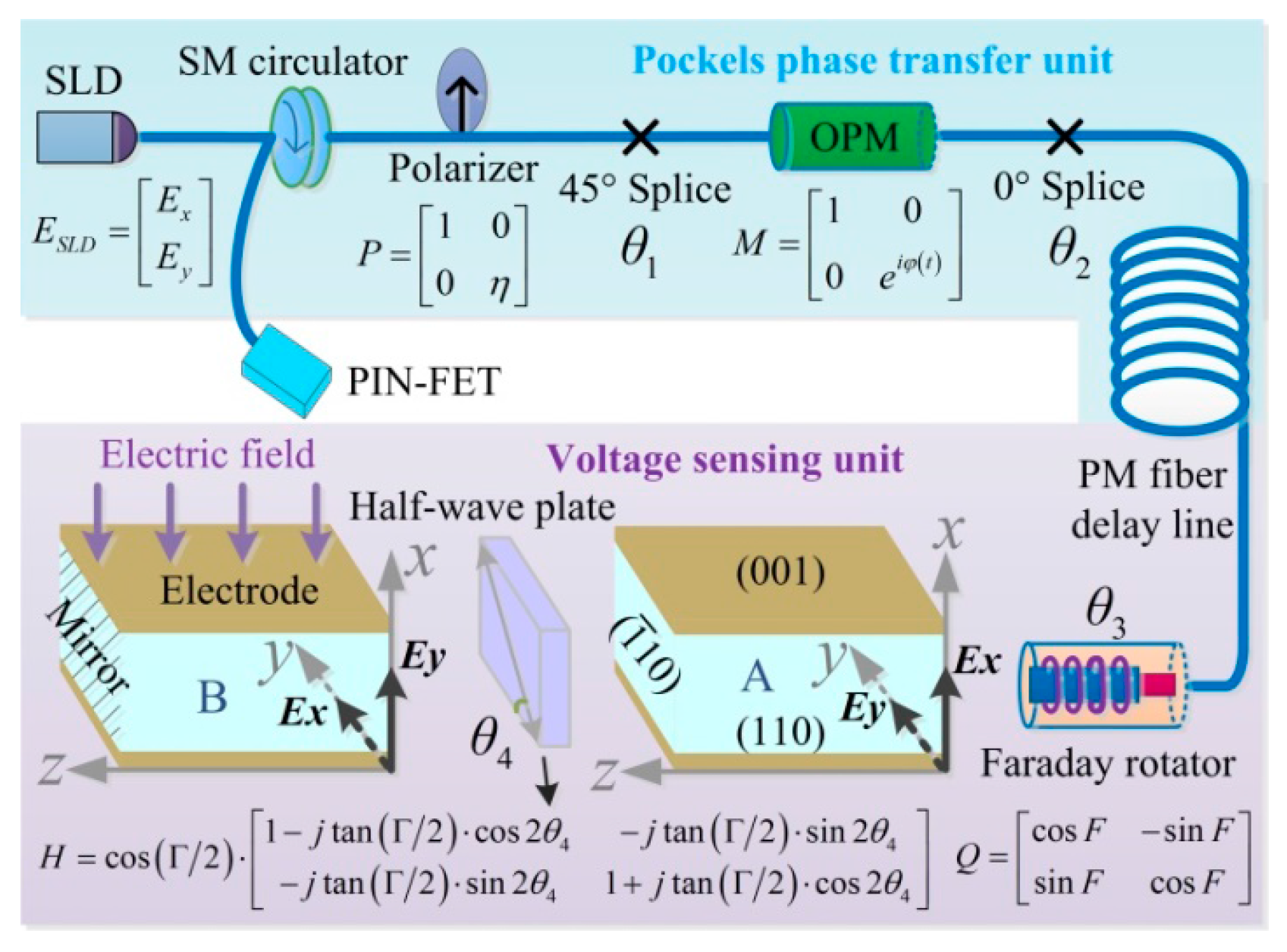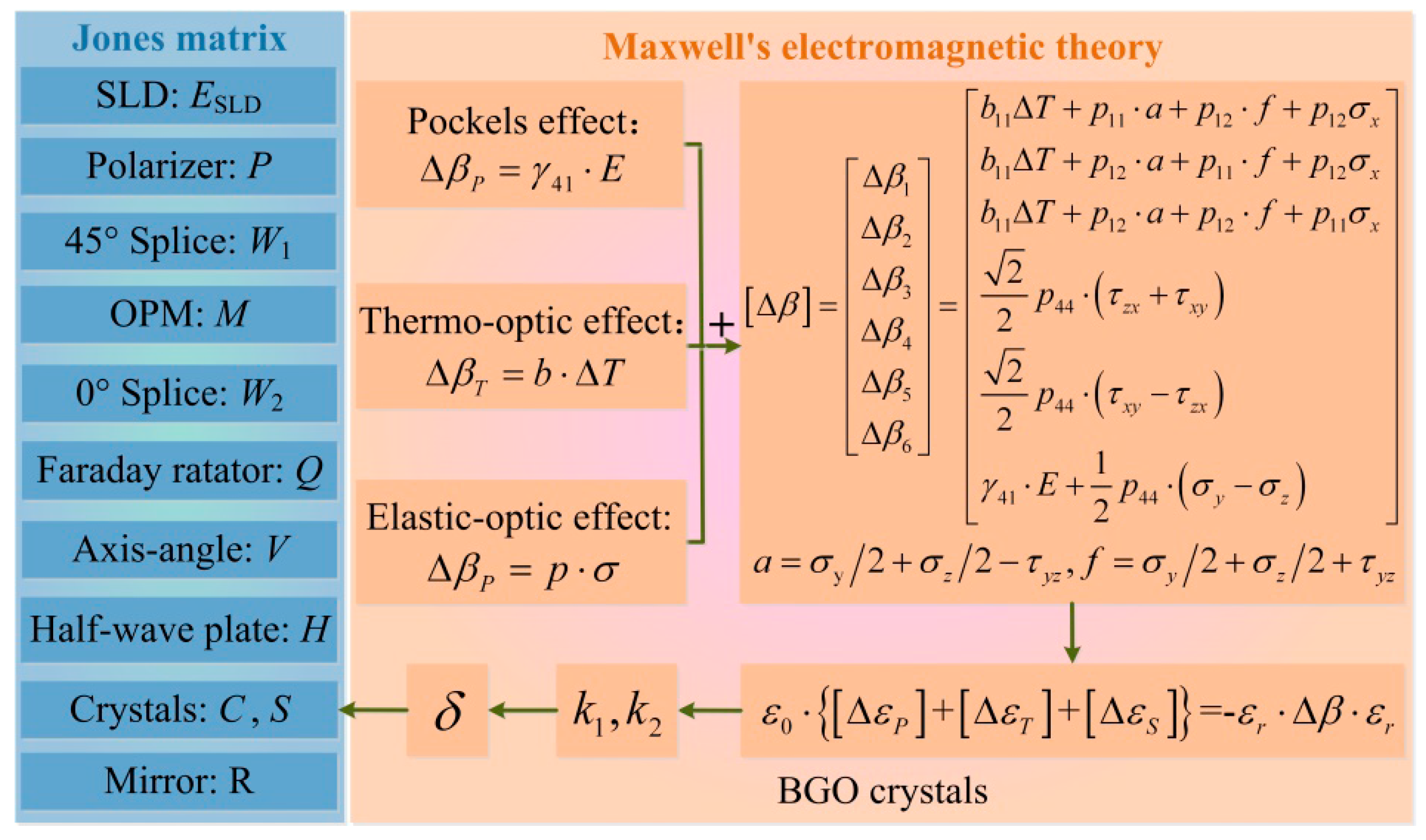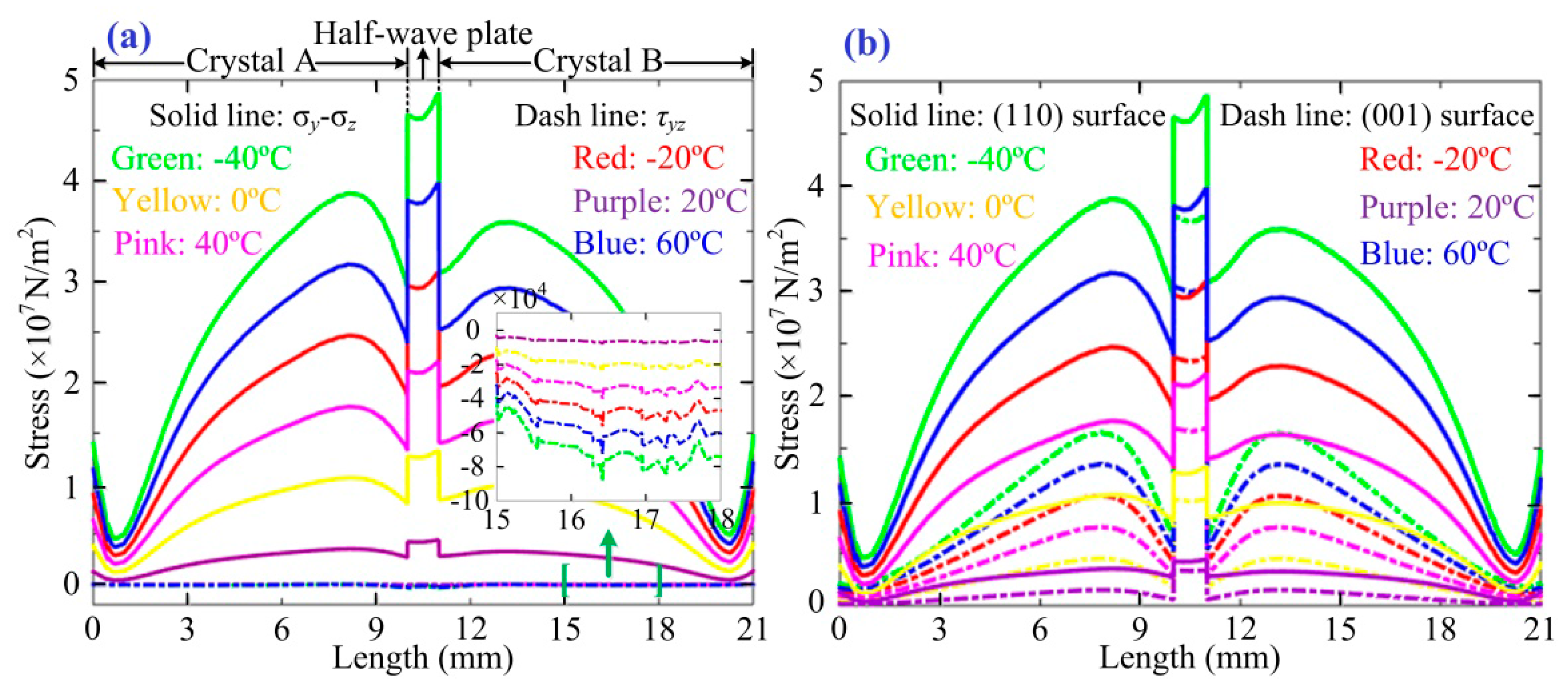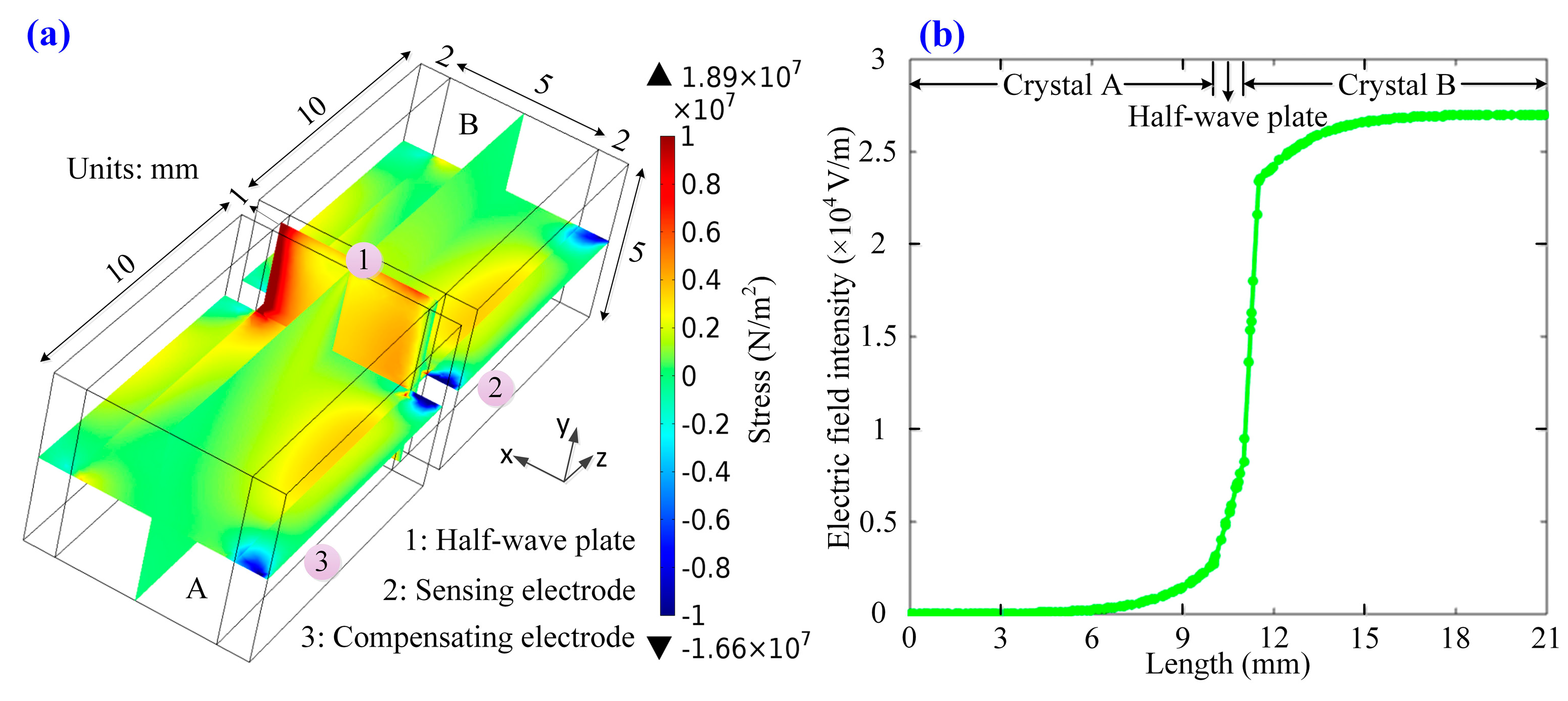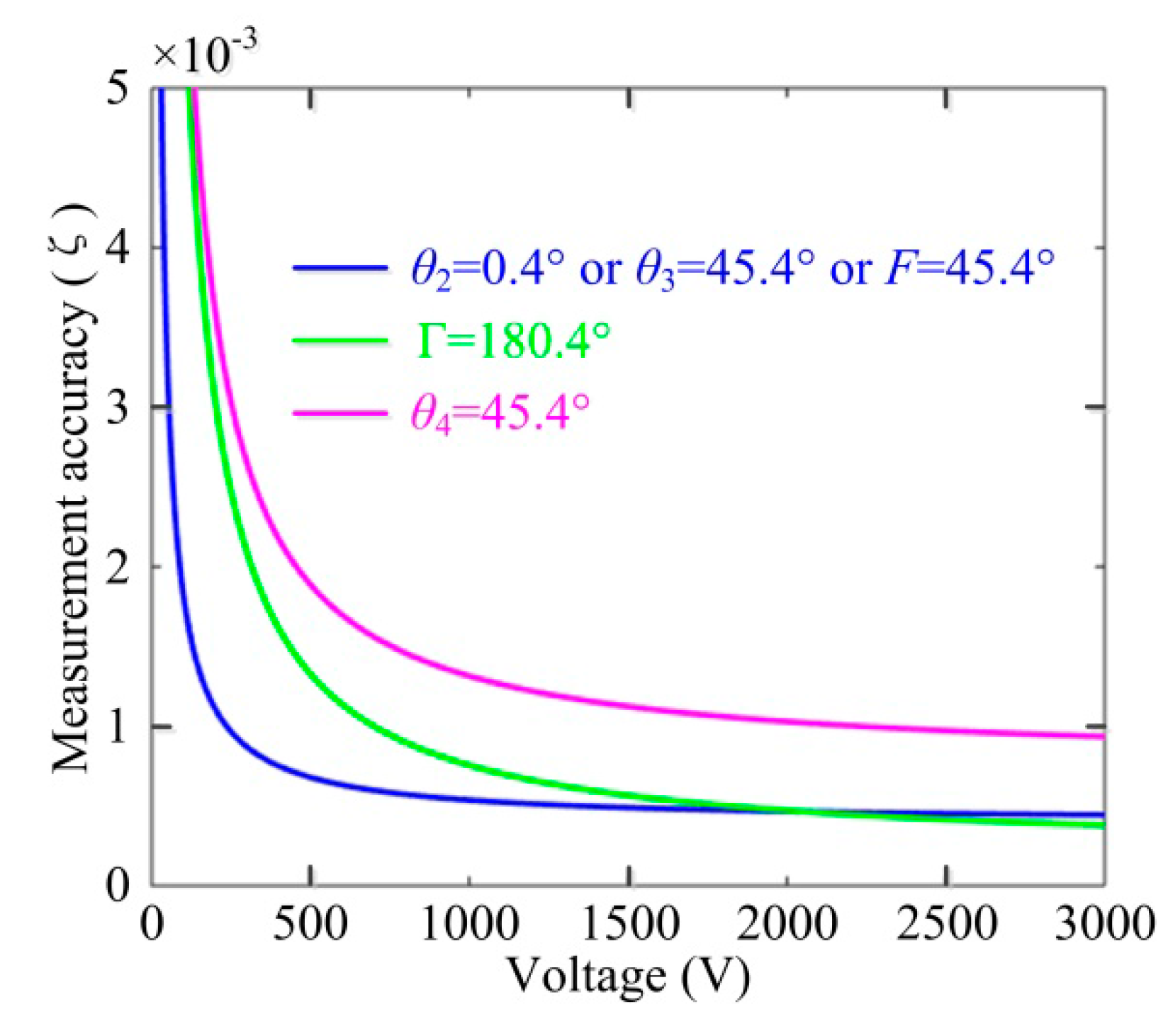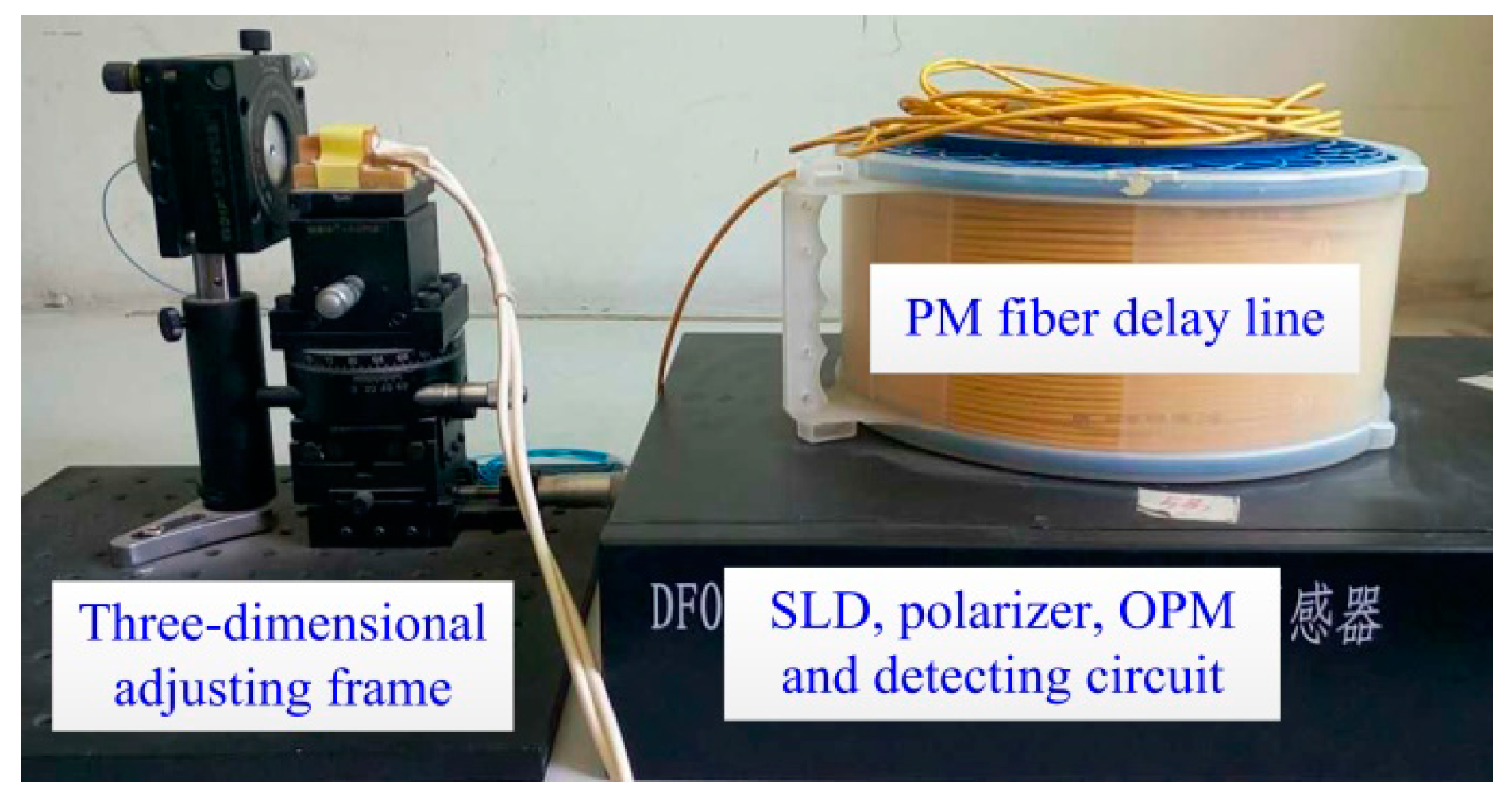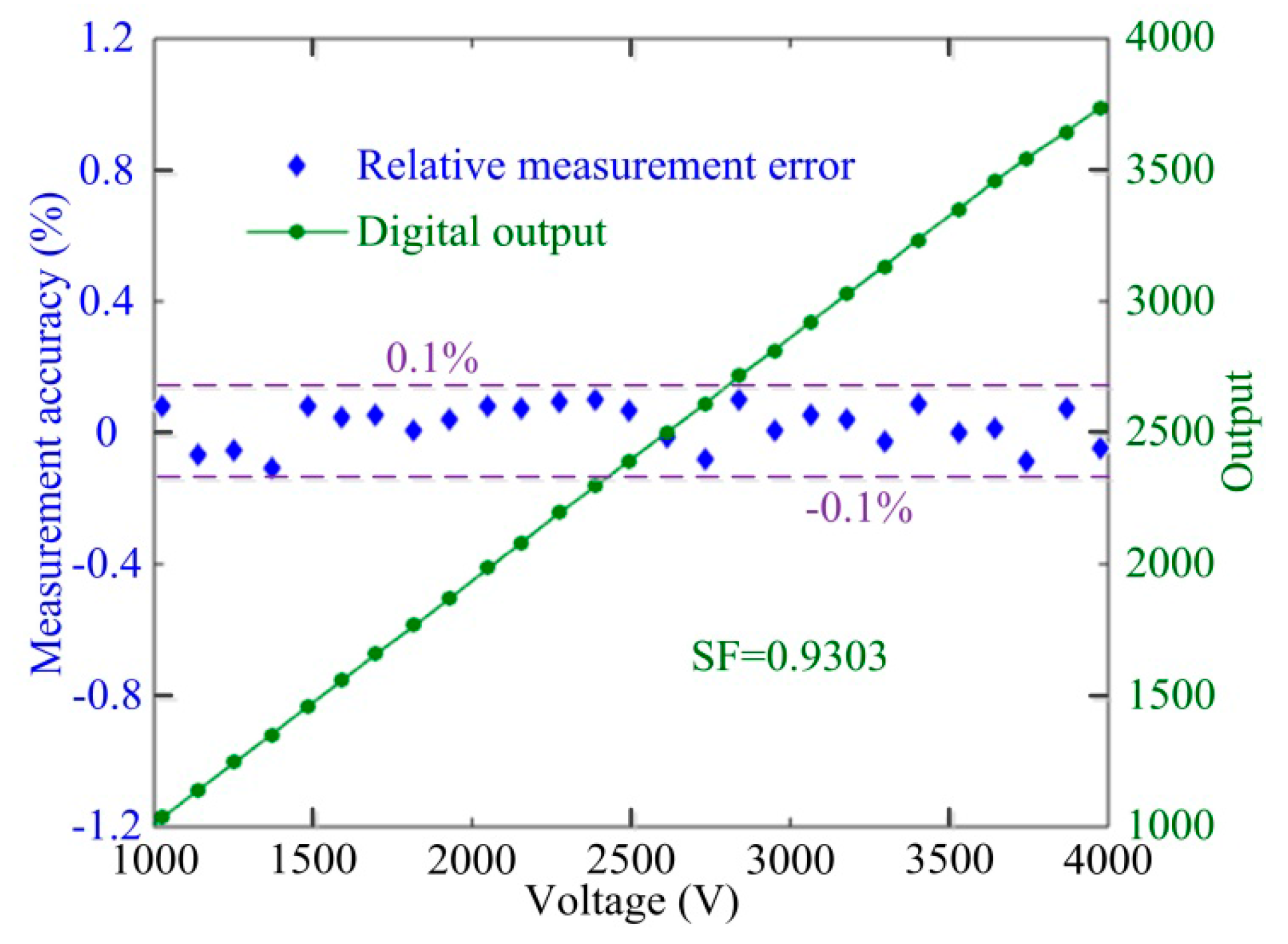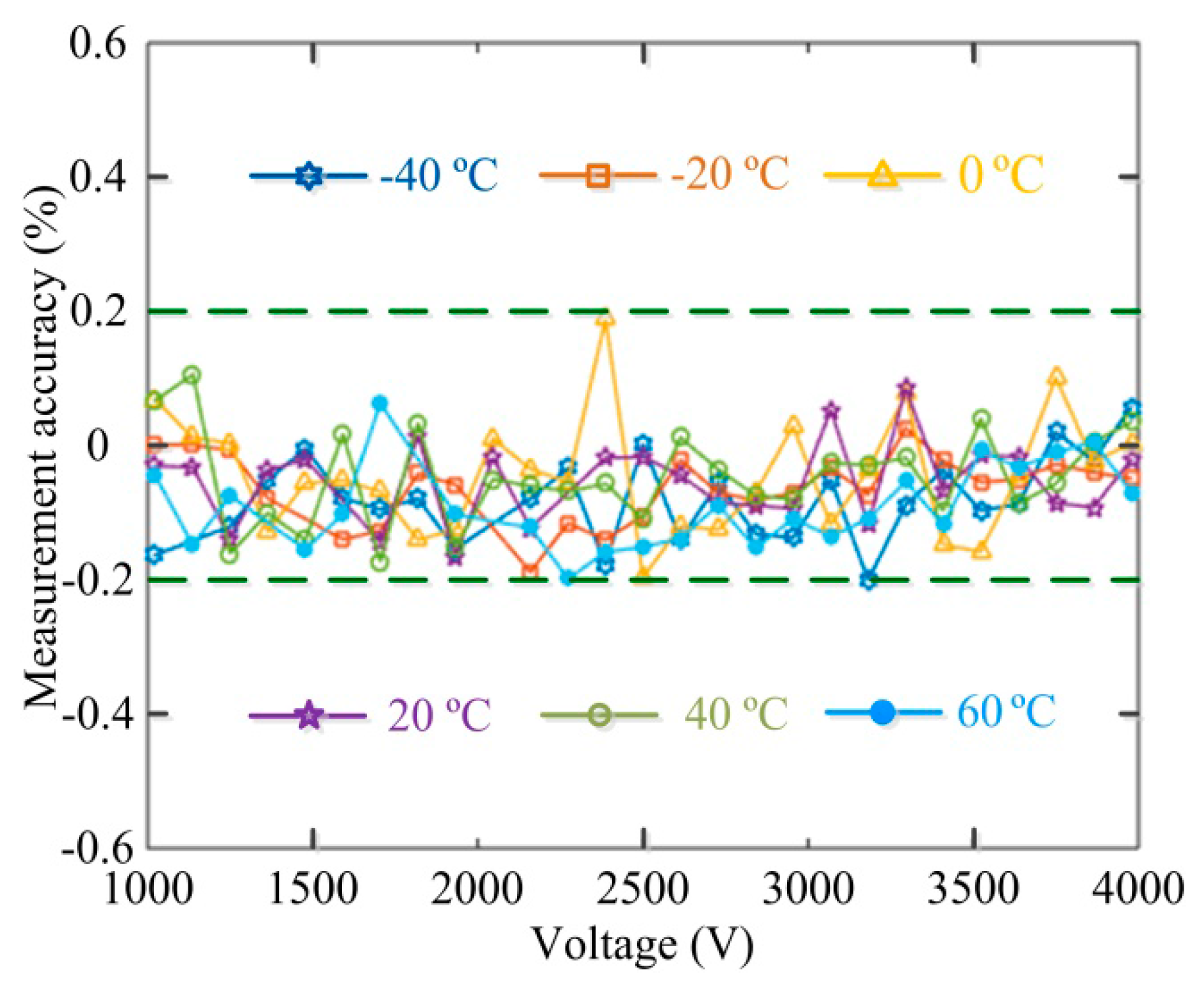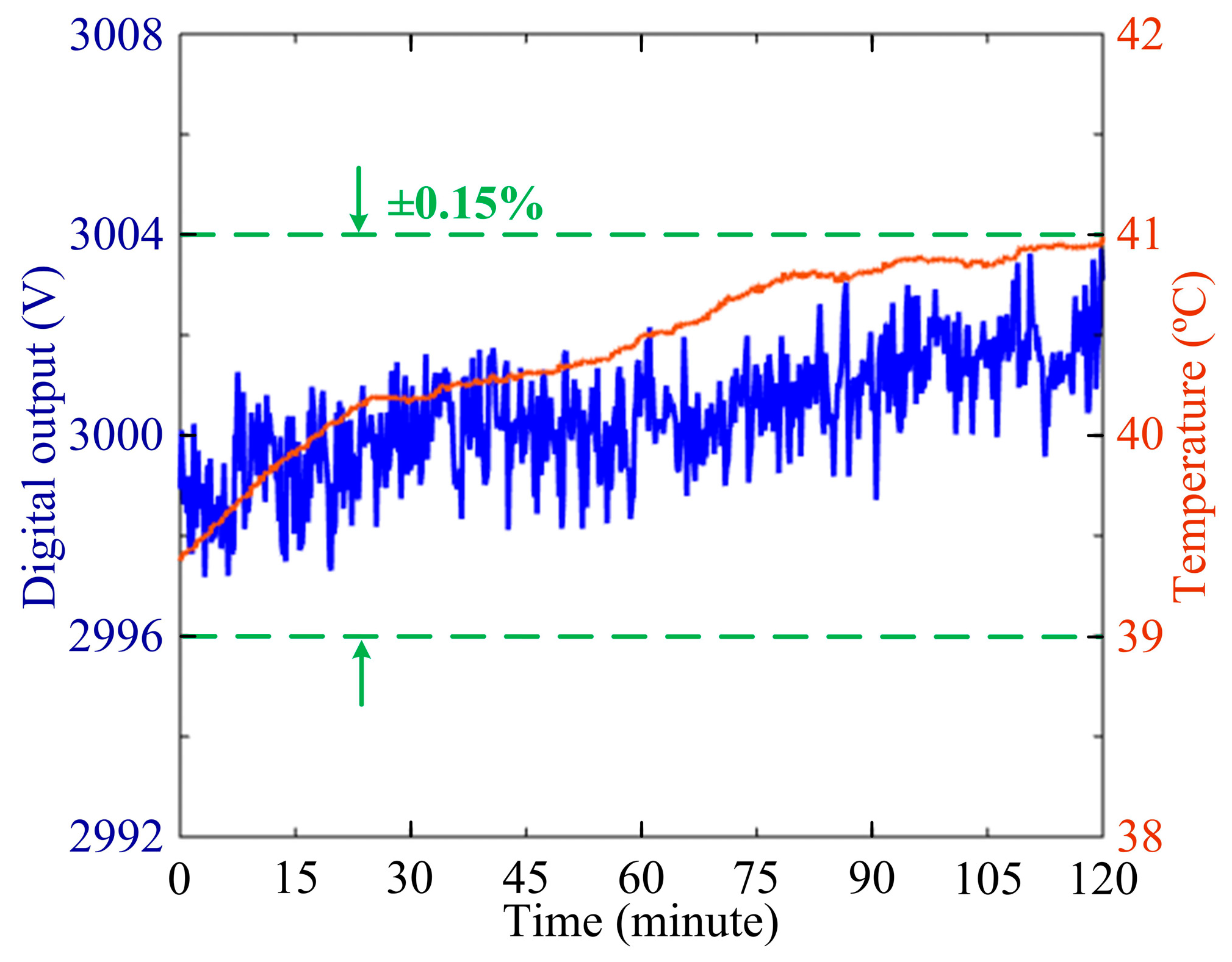The optical structure of OVS includes the Pockels phase transfer unit and the voltage sensing unit. In the Pockels phase transfer unit, the light emitted from the super luminescent diode (SLD) passes through the single mode (SM) circulator and gets polarized by the polarizer. Then, the light is split into two orthogonal linear-polarized lights by a 45° splice before propagating into the optical phase modulator (OPM). The reciprocity of the voltage sensing unit is realized by the two orthogonal polarization modes swapped in the dual-crystal that neutralize the temperature errors. The lights retrace the original path after being reflected by the mirror of crystal B, then interfere at the polarizer with a double Pockels phase, and finally enter the PIN-FET.
The working principle of the proposed OVS is shown in
Figure 1, where voltage is only applied on crystal B. The axes
x,
y,
z are the voltage-induced principal axes of refractive index of the BGO crystal, and
Ex and
Ey are the oscillating directions of the two orthogonal linear-polarized lights, respectively. The optical parameter
η is the polarizer’s polarization extinction coefficient,
θ1 and
θ2 are, respectively, the practical welding angles of the 45° splice point and 0° splice point,
φ(t) is the modulation phase applied on OPM,
F is the actual rotation angle of the Faraday rotator (FR),
θ3 is the actual axis-angle between the FR and the BGO crystal, Γ is the actual phase delay angle of the half-wave plate, and
θ4 is the actual axis-angle between the half-wave plate and the BGO crystal.
The scheme of dual-crystal optical structure is reciprocal theoretically [
18]. However, the practical uncertainty of optical parameters has a negative impact on the reciprocity of the Pockels phase transfer unit. Meanwhile, the inhomogeneous temperature field of the dual-crystal structure will cause the reciprocity degradation of the dual-crystal sensing unit, which is neglected in the previous related research [
18]. Thus, the model analysis of the optical voltage sensor for suppressing unreciprocal errors is of great significance in order to improve the OVS working performance.
2.1. Optimal Design of Dual-Crystal Unit
Firstly, the model for the voltage sensing unit is set up by taking the unideal optical parameters into consideration under multiple physical fields. The light propagation equation in the dual-crystal is given by:
where
E is the electric field intensity,
ω is the angular frequency,
μ is the permeability of the BGO crystal, and
ε0 is the permittivity of the vacuum. The tensor form of the relative dielectric constant of the BGO crystal under the ideal isotropic situation is
, where
εr is the relative permittivity of the crystal. However, due to the Pockels effect, thermo-optic effect and elastic-optic effect, the ensuing variations of relative dielectric tensor Δ
εP, Δ
εT and Δ
εS should be taken into account, respectively.
To obtain Δ
εP, Δ
εT and Δ
εS, we build an OVS simulation platform considering the influence of the applied electric field, the temperature field and the stress field on the crystal optical properties. As depicted in
Figure 2 and mentioned previously, the total variation of the inverse dielectric tensor is [Δ
β] = [Δ
βP] + [Δ
βT] + [Δ
βS], where [Δ
βP], [Δ
βT] and [Δ
βS] are caused by the Pockels effect, the thermo-optic effect and the elastic-optic effect, respectively. The quantities
b11 and
p11,
p12,
p44 are the thermo-optic coefficient and the elastic-optic coefficients of the BGO crystal, respectively.
γ41 is the electro-optical coefficient of the BGO crystal. Δ
T represents the temperature variation. σ
x, σ
y, σ
z and τ
xy, τ
yz, τ
zx are, respectively, the normal stresses and the shear stresses on the crystals. According to the variation in the inverse dielectric tensor, we acquire the variable quantity of the BGO crystals’ dielectric tensor.
Based on the proof given in the
Appendix A, we also simulate the distribution properties of (
σy −
σz) and
τyz along the light propagation path, as shown in
Figure 3. We can see that (
σy −
σz) is much greater than
τyz that indicates the latter can be omitted. Meanwhile, the orders of magnitude of (
p12 −
p11) and
p44 are 10
−13 and 10
−12, respectively [
19], and we know that
εyy −
εxx = Δ
εyy − Δ
εxx = 2
εr2·
τyz(
p12 −
p11) and
εxy·
εyx =
εr4·[
γ41·
E +
p44·(σ
y − σ
z)/2]
2. Then, we can conclude that (
σy −
σz) is the key factor that influences the OVS temperature stability.
Based on the infinitesimal method, crystals A and B are equally divided into q segments, whose crystal lengths satisfy l = q·Δl, where q is large enough. Moreover, we suppose that σyc(h) and σzc(h), σys(h) and σzs(h) are, respectively, the normal stresses on crystal A and crystal B, where h = 1, 2, …, q. Considering that (εyy − εxx) << εxyεyx, we can derive that , where . Similar to the analysis of crystal A, the equivalent Jones matrix of each segment in crystal B is given by , where .
By substituting the Jones matrix of the half-wave plate
H and assuming that the ideal matrix is
, we have the equivalent Jones matrix of the dual-crystal sensing unit:
Based on the above theoretical analysis, the phase-delay caused by the Pockels effect is herewith obtained:
Finally, it can be deduced that if we want to achieve higher OVS measurement accuracy without being affected by the external stress, the external stress should satisfy the following equation:
i.e., the spatial distribution of (
σy −
σz) in the dual-crystal should be symmetrical.
The simulation results about the distribution of (
σy −
σz) are described in
Figure 3. It is noted that the temperature variation may destroy the symmetry of the distribution of (
σy −
σz) in the two crystals when the (110) surface of crystal is fixed. However, if the (001) surface of crystal is fixed on the mechanical device, the minimum absolute value and good distribution symmetry of (
σy −
σz) are guaranteed in the two crystals. According to the above theoretical analysis of the key parameters of the OVS reciprocity degeneration, a novel structure of the dual-crystal sensing unit is designed, as shown in
Figure 4a.
Figure 4a shows the spatial distribution of stress (
σy −
σz) in the novel structure of the dual-crystal sensing unit. This compensation effect is nearly equivalent to
σys =
σyc,
σzs =
σzc, so that OVS can effectively offset the unwanted stresses on the crystals caused by temperature variation. Then, we obtain that the ideal equivalent Pockels phase in crystal A and B:
δ = π·
l·
n03·
γ41·
U/(
λ·
d).
The electric field distribution along the light propagation path in the dual-crystal sensing unit is also simulated when a measured voltage of 1 kV is imposed on the electrodes of the crystal B as shown in
Figure 4b. We can see that the novel structure of OVS guarantees the uniform distribution of the electric field in sensing crystal B, while the electric field of compensatory crystal A is nearly zero.
2.2. Error Analyses and Optimization of the Pockels Phase Transfer Unit
Based on the new sensing structure, the light transmission model can be established and the influence of the unideal optical parameters on the measurement accuracy of OVS can be investigated. The models of axis-angle errors are depicted in
Figure 1, where the light transmission model in the OVS has the form:
where
τ is the transmitting time during the back and forth process,
B(
t) =
P·
W1·
M(
t)·
W2,
D =
V·
C·
H·
S, and
W1,
W2 and
V satisfy
,
i = 1, 2, 3, as described in
Figure 1 and
Figure 2. Therefore, the interference light intensity that the PIN-FET captures is:
As only the 45° splice has unwanted welding angle error, the interference light intensity, based on Equation (6), can be rewritten as:
where
θ1 is the actual welding angle of the 45° splice. In closed-loop detection,
φ(t) −
φ(t-
τ) =
φb +
φf, where
φb = π/2 when
t = (2
k + 1)·τ and
φb = −π/2 when
t = 2
kτ (
k = 0, 1, 2, …),
φf is the closed-loop feedback phase, which is equivalent to Pockels phase 2
δ. Then, we can have:
It is noted that
θ1 only affects the interference intensity instead of the feedback phase and the interference light power fluctuation can be suppressed by using the closed-loop detection method [
14,
15]. Due to the two orthogonal linear-polarized beams generated after passing the 45° splice, the unideal welding angles before OPM have no influence on the feedback phase. Therefore, it is obtained that the unideal polarizer and 45° splice are not the key factors that affect the voltage sensor capability.
Furthermore, the influence of the key axis-angle errors on the OVS working performance can be explored according to Equations (5) and (6), as well as the simulation platform of OVS. Supposing that one of
θ2,
F,
θ3, Γ and
θ4 is +0.4° while others are +0.1°, we can analyze the impact of these angle errors on the OVS measurement accuracy using the simulation platform shown in
Figure 5. The relative measurement error of OVS can be expressed as
ζ = |
φf − 2
δ|/2
δ × 100%. Note that the axis angle between the half-wave plate and BGO crystal,
θ4, is the most significant factor that affects the measurement precision of OVS.
Now, a detailed theoretical analysis of the main axis-angle error of OVS can be conducted. Assuming that only
θ4 has an angle error, one can obtain the interference light intensity based on Equation (6):
where
θ4 is the actual axis-angle between the half-wave plate and BGO crystal. With the similar deducing process of
θ1 in the closed-loop detection, the influence of
θ4 on the interference light power intensity can be rewritten as:
where 2
δu is the function of 2
δ and
θ4. One can find that the relationship between the feedback phase
φf and 2
δ becomes nonlinear due to the unideal
θ4. The feedback phase of the real closed-loop detection system is used to offset 2
δu, which is relevant to 2
δ and satisfies
φf − 2
δu = 0. Therefore, the practical feedback phase is given by:
Moreover, the influence of the imperfect phase delay angle of half-wave plate Γ is similar to the unideal
θ4. Thus, it is obtained that the unideal half-wave plate and the axis-angle error between the half-wave plate and BGO crystals will arouse the nonlinearity of OVS and that the unideal axis-angle will induce the relative measurement error of OVS, as depicted in
Figure 6.
As a matter of fact, the axis-angle errors of the optical components are inevitable and it is also difficult to quantify them during the manufacturing process. However, with our simulation platform, we notice that the axis-angle errors between different optical components can aggravate or offset the influence on OVS working capability. The simulation results are shown in
Table 1 and the measurement accuracy of OVS can be optimized by compensating the axis-angle errors based on these results. The mean is if
θ4 is less or greater than the ideal value, the actual welding angle of the 0° splice (
θ2), the actual rotation angle of FR (
F) and the actual axis-angle between FR and the BGO crystal (
θ3) should also be constructed less or greater than the ideal angle. In general, a better axis-angle compensation of our proposed configuration can be achieved with a smaller nonlinear OVS system.
In this work, the key parameters of the stress distribution symmetry are investigated in order to build a novel sensing device, which can counteract unwanted stresses of the two crystals caused by temperature variation. And, the angle-axis compensation method is proposed to neutralize unavoidable axis-angle errors of optical components in the manufacturing process for improving the linearity and measurement sensitivity of OVS. These novel methods improve the measurement precision of OVS under different temperature environment, which also promote the performance of OVS to the measurement of higher voltages in transmission lines.
